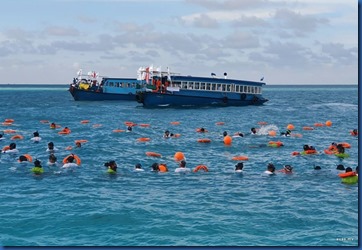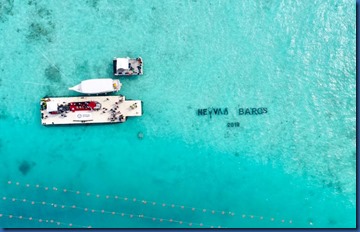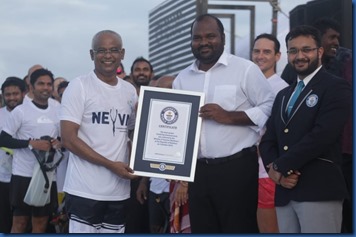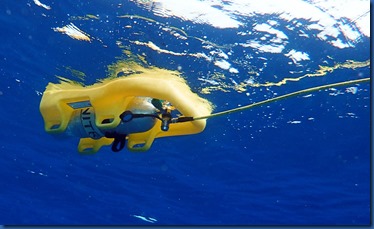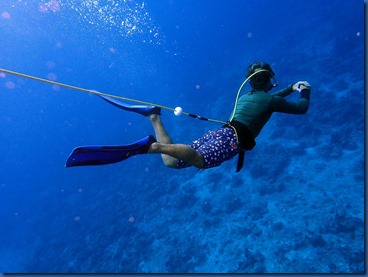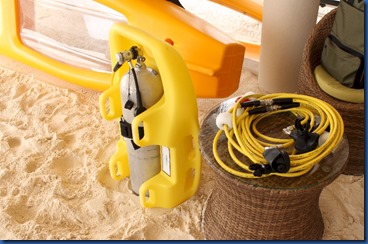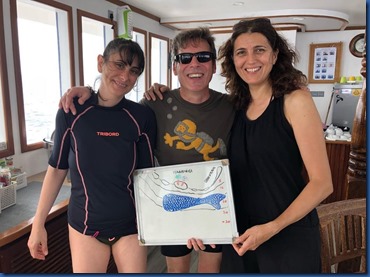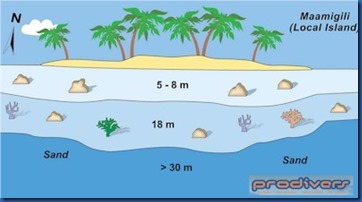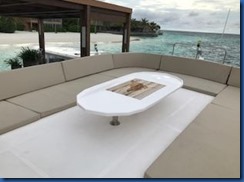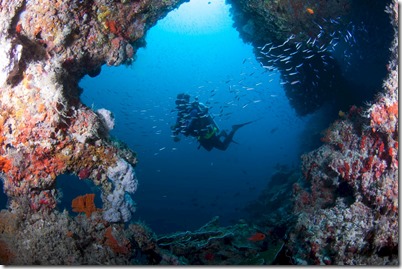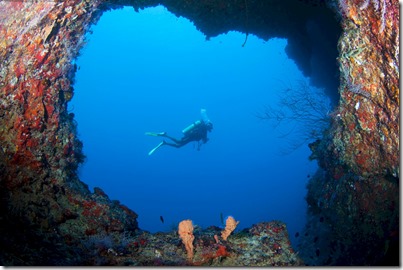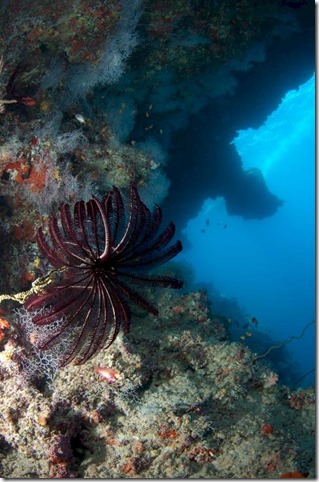For those who prefer their resort (wo)man caves underwater, Amilla Fushi’s house reef features a striking cave right on its house reef. The Blue Hole is a popular dive site in the area exits and entries at different depths in three different places. It opens at 5 meters and then has exits at 12 and 21 meters.
Best of the Maldives: Record Group Freediving – Baros
A multitudinous school of freedivers took to the Maldives’ water near Baros to set a new world record for group freediving. The MMPRC reported:
“Maldives goes on Guiness World Record for the most people freediving simultaneously, with 520 participants on Tuesday, 1 October 2019. The small island nation renowned for its breathtaking natural beauty and luxury hospitality broke the world record previously held by Italy; ‘La Scuola del Mare 2’ (Verona), in Torri del Benaco, Verona with 280 people.”
Best of the Maldives: “Peter” Diving – Faarufushi
[NOTE: This offering is no longer at the resort…an opportunity for a “not yet seen again” feature for some resort.]
Despite its fame as a diver’s paradise, we didn’t dive in the Maldives until about our fifth year of going there. Lori’s sister did diving and Lori decided to get certified to join her when the sister came along with us one trip. Even then, I stayed up on top snorkelling with the kids. I remember one day, the kids and I were just finishing with the morning house reef snorkel when Lori was just setting out on her dive. She had to get the gear ready while we just threw on our fins and masks and jumped in. When she got back, we asked what she had seen on the dive. Sharks, morays, colourful fish, sting rays. It was all the stuff we had seen snorkelling. I continued to question why bother with all the equipment and faff of scuba diving when so much can be seen so close to the surface.
Since those days, I have succumbed and gotten my PADI Advanced Open Water and done over 60 dives there. And they have all been delightful. I still make a point to snorkel every house reef and there is still something alluring about the simplicity of snorkelling – no encumbrance, the ability to pop your head up and talk to your buddy, the sun on your back.
But I will admit that you do have to deal with the nuisance of seawater sloshing into your snorkel and being limited in how long you go underwater before you have to return to the surface for a breathe. Faarufushi’s “Peter” breathing system provides the unencumbered simplicity of the snorkelling experience with the underwater breathing freedom of a scuba system. Instead of the air supply being strapped to you, it floats on the surface and follows you through an extra long regulator tube.
Another benefit of the Peter is for giving people a stepping-stone taste of the scuba experience. Many dive centres offer complimentary “Try Dive” sessions. You put on all the scuba gear and have a little underwater swim in the safe confines of the shallow lagoon. But the Peter sessions are even less effort and might serve to ease more people into the underwater experience.
The “Peter system is also featured at Sun Siyam Irufushi and Kandooma resorts, but at Faarufushi it is included in their AI package.
Best of the Maldives: Easy Wipe Forms – Reethi Faru
For decades, the dream of the digital revolution was the eco-friendly paperless office. Yet, despite the profusion of connectivity and devices, dead trees still seem quite prevalent in the world of administration. You can understand that there are just some areas and applications where electronic record keeping is just impractical. Like on a dive boat where water is sloshing around and the risk of loss is high. Still, despite the extra obstacles of its environment, the Sea Explorer dive centre Reethi Faru is one of the most radically paper-free operations I have come across.
And they have not had to invest tons of money into fancy applications and sophisticated electronics. Just some clever approached. Their innovation is simply to laminate all their forms and fill them out with easy-wipe markers. Once completed, the centre takes a smartphone picture of the phone and saves it electronically. Simples. They use this technique for their registration forms, nitrox logs, dive logs and every part of their business that needs something completed and recorded.
Best of the Maldives: Soft Coral Wall – JA Manafaru
When we think of coral reefs, we often think of the hard corals whose calcium carbonate exoskeletons are the stuff that this destination is made out of. But just as dazzling to the undersea adventurer are the colourful soft corals that line walls and often caves on the reefs. And the best dive spot for soft corals seems to be Becky’s Caves according to a number of experts I’ve conferred with. It is a site for Advanced divers as the sub-aquatic display, described as “lots of soft corals all coming out like grapes” starts at 22 metres deep. The nearest resort, JA Manafaru’s “Sun Diving School” describes it as
- “This reef is the north side of Madulu Island. The top reef starts from 7 meters and drops down until 20-25 meters depth, showing all its beauty. It is a real wall reef, where you can meet napoleon fishes, red snappers and morays, lion fishes and different kind of nudibranches in the small overhangs. At the depth of 20 meters, one huge recess of the reef shows on one side a wall completely covered of soft corals of different colors; from yellow, pink, white to orange, a real universe of colors! Bring with you your torch and your camera: one fantastic dive for everybody but one rare show to see!”
Best Dive Chart
What is a complete guide to the Maldives without including the underwater wonderland that surrounds every resort? Which is why I introduced features like the Snorkel Spotter and the Dive Site database (over 1800 Maldives dive sites and counting).
I have a particular aesthetic fondness for the colourful dive site charts used to brief dives. Some are slick computer generated cartography while others are rough, smudged sketches. They all have their individual charm and story to tell about the aquatic world you are about to explore. But having curated hundreds of these diagrams, I spotted what has to be my all-time favourite on Instagram last week depicting Maamigili
in South Ari Atoll. I actually had a dive chart for that site in that database (see below), but it was nothing like the oeuvre of the Indico’s Secret dive crew (above).
Oftentimes, the charts focus on depth changes, key positional markers and the occasional resident marine life. This version was all about the latter. A whale shark to be specific. Let’s be absolutely clear here…when you are diving Maamigili, you have one thing, and one thing only in your mind and sights – spotting a whale shark. So rather than faffing around with lots of irrelevant topological features, the dive master simply drew ‘this is what we are jumping in the water for…good luck spotting’.
Best of the Maldives: Speed Dive Boat – Hurawalhi
If you want to get to see your sharks with jet speed, then Hurawalhi offers a diving speed boat. Not a typical diving dhoni that chugs along to your dive site, but a proper speed boat that gets you there in half the time. It not only saves time just sitting on the boat when you could be back on the resort sipping pina coladas, but is handy in other ways. The dive masters got reports of a juvenile whale shark in the area and in the boat we were able to do a quick reckie to see if it was still around before proceeding home (no luck).
Best of the Maldives: Leaf Fish – Ayada
When you first start diving, the big bold animals are the most alluring – sleek sharks, hovering turtles, soaring mantas. Over time, you start to get more enchanted by the more elusive creatures – tiny nudibranchs, camouflaged stone fish, hidden octopi. The dive becomes more of a treasure hunt than a safari.
One of the classic, masters of disguise is the leaf fish. If your bucket list includes one of these elusive creatures, then one treasure map is provide by Alexander Von Mende who points us to Mafzoo Giri in the Gaafu Alifu atoll: “You will find a large coral block at around 15m that hosts no less than six residing leaf fish behind a dizzying wall of glass fish.” And if you want the most convenient access, the closest resort is Ayada.
Maldives’ Best Dive Sites in Each Atoll
If you can only dive one dive. This is the question we often find ourselves asking during our tours as we will typically spend only one or two nights at a resort and so only have the opportunity for one dive. So when we are planning our dive, we will ask, “well, what’s the best dive around here?” Even for people with the luxury of an extended stay, this is a fairly typical question. When we were having longer stays with the family years ago, we would still ask this question. Many times, we loved the dive so much we just opted to keep repeating it through the week (we went to Manta Point during our Kurumba stay three times).
One common feature that I noticed about many of the selections is that they are situated in channels at the edge of the ocean where the open water merges with the protected inner atoll waters. Such dives will often have a degree of current to them which limits them to AOW divers, but it is the current which contributes to the marine life and activity there.
For the research, I relied on the input from a range of dive schools and dive masters I have met over the years as well as Sam Harwood’ and Rob Bryning’s superlative book “Dive the Maldives” with occasional reference to Tim Godfrey’s “Dive Maldives”.
The list below is admittedly extremely subjective, but the choices are as good a place to start as any. I welcome suggestions and alternative proposals in the Comments section.
- Addu: Maa Kandu East (Mudakan) – 3 of the 7 top dive sites reviewed by Harwood here have the top 5-star rating, but Mudakan is the most accessible and the only one with also a 5-star snorkelling rating. “With magnificent table and brain corals, schools of fusilier, turtles, eagle rays, and sometimes manta make this beautiful dive an absolute joy.”
- Baa: Hanifaru Bay – This Marine Protected Area has become so legendary that the government has actually put up restrictions on diving there. Still, divers can dive around the limits with the best chances to see its bountiful mantas and even the occasional whale shark.
- Dhaalu: Fushi Faru – Recommended by St. Regis Vommuli dive centre Manish Mahadik saying, “An abundance of marine life including big schools of reef fish, colorful coral, lobsters, occasional Eagle Rays, Moray Eels and sharks…suited for all experience levels from beginner to advanced.”
- Faafu: Jumping Jack – Recommended by Werner Lau as “This is one of our top dive sites [in the Maldives]. With milder currents, it offers less experienced divers a really truly pleasurable diving experience. Seven beautifully overgrown tilas on the outer reef edge connect the farus to the north and the south of the channel.”
- Gaafu Dhaalu: Mafzoo Giri – One of two dive sites in the entire “Huvadhoo” (Gaafu Alifu and Gaafu Dhaalu together) atoll with 8 stars (out of possible 10 – 5 for Fish and 5 for Coral) by Alexander von Mende who wrote an entire guide book just on diving the atoll. And one of just 2 (with Kondey Kandu) with 5 stars for Fish. “Offers a lot for its size…hosts no less than six residing leaf fishes behind a dizzying wall of glass fish.”
- Gaafu Alifu: Mas Thila – One of two 7 star sites (out of possible 10 in von Mende’s book) and described as “a real jewel…one of the best dive sites in Huvadhoo”.
- Haa Alifu: Becky’s Caves – Recommended by a number of dive masters to us. The nearest, JA Manafaru’s Sun Diving School describes is as “At the depth of 20 meters, one huge recess of the reef shows on one side a wall completely covered of soft corals of different colors; from yellow, pink, white to orange, a real universe of colors! Bring with you your torch and your camera: one fantastic dive for everybody but one rare show to see!”
- Haa Dhaalu: Heaven & Hell Thila – The choice of Miranda Pontiglione, Base Leader at the Barefoot diving center – “For sure this is one of the best diving spots in our area. All the thila is covered by big colourful soft corals. Along the thila wall there are many overhangs where you can find cleaning shrimps, lobster, groupers and moray eels. A couple of canyons located in the deepest part of the thila will make your dive unforgettable.”
- Laamu: Fushi Kandu – Commended by Ocean Dimensions’ Petra Hellaman at Six Senses Laaumu who says it is especially great for seeing sharks. “The most spectacular dive is when divers cross the channel…Then, divers can swim inside the atoll to try to encounter dolphins” (Daily Dive).
- Lhaviyani: Kuredu Caves – I was told about this site by a number of Maldives aficionados before I finally got there and having dived there it remains one of my top ten most memorable dives ever. The highlight is the turtles. Not just lots of them, but the biggest turtles you will ever see. Honorable mentions to the striking “Shipyard” double (!) wreck site with the distinctive vertical wreck (whose bow protrudes out of the water).
- Meemu: Mantas and More – The consensus recommendation from both dive centres in the atoll. “Nearly untouched dive sites are easy to dive and feature a great diversity of corals and fishes. Several spectacular channels, e.g. Mantas & More, count amongst the top ten in the Maldives” -Werner Lau
- Noonu: Dhiffushi Kandu – One of two sites called out by Harwood in Noonu “The highlight of this dive are the sightings of the large Green Turtles that inhabit the reef feeding off the sponges and corals. The reef has excellent fish and this is a great dive.”
- North Ari: Miyaruga Thila – Tim Godfrey uses a 4-star rating system where only 4 dive sites out of the nearly 300 he reviewed in all the Maldives got the top mark – and 3 were in the North Ari Atoll. Of those, got the strongest coral rating. Godfrey describes Miyaruga, “The landscape is stunning and divers can easily circle the reef in one dive if the current permits…Much of the thila is undercut with caves and the surface is coated in soft coral and colourful sponges.”
- North Male: Manta Point – Some of the most reliable mantas in the Maldives at a prominent and conveniently close feeding station. “An astonishing number of manta rays can be seen here with they come to be cleaned” – Harwood.
- Raa: Labyrinth – The most frequently sites and raved about Raa site on the web and the Dive Point dive center describes it as, “Medium-sized Thila which has crumbled over the centuries and has thereby formed wonderful canyons and tunnels in the reef. The Thila distinguishes itself with its huge schools of fishes and coral growth (soft- and hard corals). A big number of bat fishes accompanies you on every dive on this reef.”
- South Ari: Kudarah Thila – Both Godfrey and Harwood list 2 top rated dive sites in the South Ari, but Kudarah Thila is the only one they both rate tops. “One of the most exciting dives in the South Ari” says Godfrey. I omitted the any of the diving areas on the southern tip famous for whale sharks (also an MPA) because there is no single one that predominates, diving is restricted because of the whale sharks, and snorkelling is often a better way to find and see them.
- South Male: Kandooma Thila (aka Ran Thila) – Pretty much uniformly recommended to us by dive centres as Cocoa, Olhuveli, and Rihiveli and the only 4 star dive site in South Male in Godfrey’s “Dive Maldives” (“one of the most exciting dive sites in South Male Atoll and boasts great scenery as well as prolific fish life”)
- Thaa: Guraidhoo Corner – The only Thaa dive site noted by Harwood with a 4-star dive rating, “A large crevice in the drop-off with over hangs and caves and swimthoughs. Here as the current eddies, huge balls of snapper, rainbow runner, jack fish, tuna and shark are common.”
- Vaavu: Fotteyo Kandu – One of Harwood’s rare 5-star sites, “This is a stunning, remote place and it is well worth diving here at least twice and at least 4 or 5 times to fully appreciate its beauty.”
Best of the Maldives: Most Caves – AaaVeee
You’ll need a day alone just to acclimate from your plane journey if you want to do some scuba, but you will have plenty to see if you head to the Dhaalu atoll. The atoll appears to have more caves and overhangs compared to other atolls. And the resort at the centre of it is AaaVeee whose dive centre visits the following caves sites and has shared these photos with Maldives Complete…
- Aaaveee caves – south west of the island, reef is formed like a wall slopes to 35M covered with small and big overhangs depth from 8 to 23M.
- Dhonbileh hoholha (Dhoorees kuda gaa) – long pinnacle overhangs from 4 meters to 25meters, reef slopes to 37 meters. More over hangs on south, north half of the pinnacle slopes and another half like a wall covered with soft corals and over hangs.
- Rinbudhoo hoholha – south west of the island, reef is formed like a wall slopes to 35M covered with small and big overhangs depth from 8 to 27M.
- Rinbudhoo corner – north east corner is also a wall with overhangs and there is swim through start from 12 meters to 22 meters.
- Vommuli caves – near the spa end of the island have a big overhand on the corner.


